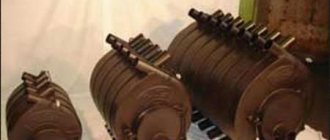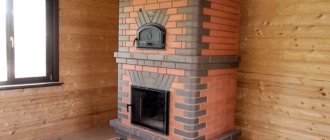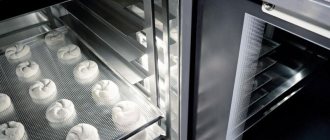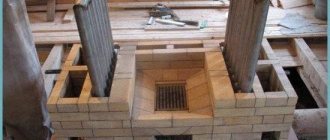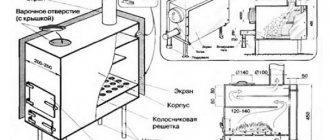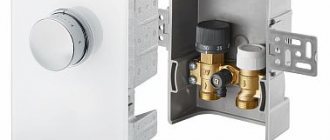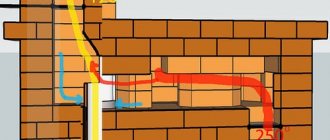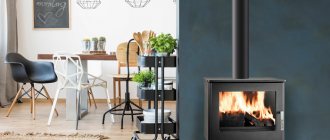Every house needs heating during long frosty winters. It would be impossible to live in a house without heat. Anyone who wants to fill their home with life-giving warmth thinks about how they organize heating.
The editors of Agronom.guru invite you to familiarize yourself with wood-burning stoves, the efficiency of which is 90%. These are the best long-burning wood stoves for your home. We have looked at all the pros and cons of such heating systems and offer to find out what types of long-burning wood stoves are available and how to operate them correctly.
Also, if you are planning to choose stoves for a wood-burning sauna, be sure to know:
- Steam room volume;
- Fuel;
- Oven type;
- Microclimate;
- Door;
Advantages and disadvantages of long-burning wood-burning stoves
Any unit has disadvantages and advantages; studying such nuances allows you to choose the optimal model for heating your dacha.
| Advantages | Flaws |
| Economical fuel consumption. | There are often difficulties with the design of the chimney. |
| High efficiency. | To implement the pyrolysis mode of the furnace, pre-heating of the house is required. Until this moment, the unit operates as usual. |
| Large selection of sizes to suit every taste. | |
| Fueling occurs infrequently: from 5 to 48 hours. | |
| Possibility of using liquid and solid fuel. |
Design of long-burning furnaces
Long-burning wood-burning stoves have their own design features. To reduce intense combustion, the air supply is controlled in several ways: upper or lower combustion and pyrolysis of wood. The most common option is top combustion. With this method, firewood smolders from top to bottom to the base of the firebox. The combustion area is limited by the supply of dosed air. Below is a picture explaining the design of a wood stove for long-term burning.
You can see the role played by the supply of cold air, a hot air chamber with a cut-off valve that meteres the supply of oxygen into the combustion chamber. Often such stoves are equipped with a convenient ash pan-scoop.
Advantages of long-burning fireplace stoves
The main feature of a modern fireplace stove is the regulated combustion process of solid fuel, which occurs in the main chamber with a certain lack of oxygen. In this mode, firewood does not flare up with a bright flame, but smolders for a long time. At the same time, a temperature sufficient for pyrolysis is maintained - the decomposition of high-molecular compounds to the simplest gases, including CO. They completely burn out at the exit from the furnace, where additional air enters in the required quantities. As a result, the maximum amount of heat is released and no harmful emissions occur.
As is known, the intensity of the fuel combustion process depends on the amount of oxygen supplied. If there is enough fuel, the fuel burns intensely, releasing a large amount of heat, but the fuel burns quickly. With limited air supply, combustion can enter the smoldering stage, in which even flames are not always observed.
In principle, any furnace can be switched to a long-burning mode by manipulating the valves. Another thing is that not all of them are designed for this mode. Conventional stoves with closed valves can even be dangerous - in smoldering mode they can become a source of smoke or carbon monoxide. So it’s better to look for a fireplace stove for a summer house whose characteristics include the line “long burning” and the maximum burning time for one bookmark. This could be 6-18 hours.
How to determine whether a stove supports long burning or not
One of the characteristics by which you can distinguish a long-burning fireplace stove for a summer residence from a conventional heating stove is its sealed design. After all, you need to make sure that air flows in the right quantity. No more and no less. The second sign is the presence of several adjustable dampers.
The tightness can only be checked during combustion, but the presence of dampers can be monitored visually and how tightly they block the access of air, you can also see how well they move. In some models, the air supply is adjusted through the ash drawer. In this case, you need to look at how well it “moves” and how tightly it blocks the air supply. Although the ash box cannot be airtight, it should not leave large holes either. You can also track the presence of a seal on the door, a gate on the pipe. All these are criteria by which you can determine whether a given fireplace stove supports long-term combustion.
With afterburning of gases
How else do long-burning stoves differ from conventional ones? The fact that they can be used to burn gases that are formed during the combustion of wood. In conventional furnaces, these gases escape into the chimney, since their ignition requires a special regime - high temperature and limited access of air. In long-burning furnaces, the fuel chamber can be divided into several parts. In one firewood burns, in the rest there are gases that were formed during the decomposition of fuel. Such furnaces are also called gas generators, since it is in the smoldering mode that the largest amount of gases is formed. What is characteristic is that most of them have a calorific value higher than that of the fuel during the decomposition of which they were formed. So when using conventional ovens, a significant portion of the heat is lost. That is why it is believed that a long-burning fireplace stove is more profitable for a summer house or home, since it requires less fuel.
The downside is that a long-burning fireplace for a summer house or home costs a lot of money. The price tag for models that support long-term combustion starts from $400-450, if it is a Russian manufacturer and the body is made of structural steel. Domestic stainless steel costs twice as much, and cast iron costs twice as much. Imported fireplace stoves with a long-burning function, with the same characteristics, are approximately 70-100% more expensive.
The difference between a classic open fireplace and a fireplace stove
A classic open-type fireplace is only an additional source of heat that cannot heat a room in cold weather. It gives heat in small quantities, it spreads only during the combustion of the fuel, and immediately before the firebox. This type of heating device is good for a damp summer or autumn/spring day. In winter, it is not able to provide enough heat for the entire room, since its operation requires good draft, which “pulls out” most of the heat.
The fireplace stove has different characteristics, a closed firebox. Such a unit can heat the room independently (with correctly selected power). And a long-burning fireplace stove for the country house and home also does this economically, as it uses fuel energy to the maximum.
Operating principle of long-burning furnaces
Let's get acquainted with the operating principle of a long-burning wood-burning heating stove for a country house. The process that occurs in the combustion chamber is called pyrolysis or gas generation. This can be described with the word “smoldering”, since the concentration of supplied oxygen is extremely low, combustion as such does not occur.
So, solid fuel is placed in the stove and set on fire. The role of the blower during ignition is important; the damper must be fully open. First, the wood is heated and completely dried. The process of heat transfer and release of flammable gases begins. These gases pass into the upper chamber and burn there. The house should warm up within 30-40 minutes. After this, close the blower damper in order to block the access of oxygen.
At this point, you can add new fuel. The combustion mode at the lower level makes the most useful use of pyrolysis gas. The chemical processes taking place in the bowels of the stove in wood fuel are such that the raw material does not burn, and in the absence of air access it releases pyrolysis gas, ash and other elements. All this combustible mass accumulates at the top of the combustion chamber and transfers heat to the walls of the furnace, to the heat exchanger or convector.
At the end of the 19th century in France, Jean Baptiste Andre Gaudin invented a clean combustion system or, as it is also called, “secondary combustion technology.” This discovery of the founder of the famous fireplace dynasty has not undergone any changes to this day. Despite the fact that the production of wood-burning fireplaces is continuously developing and technical innovations are becoming increasingly important, the method of supplying oxygen to the fireplace firebox during combustion is preserved and used everywhere. It allows you to burn particles of unburned fuel, increasing the efficiency of the fireplace and reducing the release of toxic combustion products into the external environment.
Combustion is the interaction of wood and oxygen in the form of a chemical reaction between fuel and oxidizer.
All this occurs at high temperatures and is accompanied by significant heat production. When the stove is lit, air from the room where the stove is located enters the fireplace. This initial air passes through special holes that are adjustable, and unburned fuel particles and smoke go up and are removed through the chimney using a deflector.
If there is insufficient oxygen in the firebox, the combustion process does not proceed completely, forming carbon monoxide instead of carbon dioxide, which has neither color nor odor and is extremely dangerous to health.
If white smoke comes out of the chimney during combustion, you can immediately determine that combustion is incomplete. Transparent smoke indicates complete combustion, while black smoke simply indicates damp wood. “Secondary combustion” technology helps eliminate the risks that arise from incomplete combustion. It consists in the fact that oxygen enters through the secondary air supply channels, which heats up as it passes between the combustion chamber and the walls of the housing. Next, the heated air enters the firebox through the deflector, mixes with gases - combustion products, which causes re-ignition. As a result, unburned fuel and carbon monoxide are burned, and the likelihood of carbon monoxide poisoning is minimized. The beneficial effect of secondary combustion is that it increases the efficiency of the fireplace and reduces fuel consumption.
Important! It is better to take air from outside from the street, using corrugated hoses, which are connected to stoves and fireplaces in special places. This need is due to the fact that when air is taken from the room where the combustion source is installed, the well-being of the people there may worsen. The tightness of windows and doors does not allow the oxygen levels needed in such a situation to be replenished.
Examples of fireplaces with a secondary combustion system are fireplaces from ABX and Supra.
Main technical characteristics of long-burning wood-burning stoves
Like any other device, long-burning stoves have their own technical characteristics:
- power;
- the material from which the firebox is made;
- unit weight;
- external finishing material.
The time it takes for the house to be completely heated depends on the technical characteristics, on average it is from 3 to 10 hours. The area of the heated room varies from 75 to 250 m² and depends on the design of the stove. Stoves are made of steel, cast iron or brick. Wood-burning metal stoves for homes are also in demand. For dachas, there are such convenient types of long-burning stoves as heating and cooking models, on which you can cook and warm up food, as well as fireplace stoves.
Long-burning heating and cooking stove
Types of wood stoves
Currently, there are many types of wood stoves, the most common of which are:
- Traditional. They are built from brick or stone, and are considered not only durable, but also safe. These include the Russian stove, the Swedish stove, and the Dutch stove. Such structures heat the room slowly, but they also retain heat much longer than metal ones. Today there are practically no craftsmen left who know how to build a high-quality warm stove, and you also need to know how to use it. Therefore, they are rarely staged, mainly by adherents of antiquity or exoticism.
- Fireplace s. A classic fireplace is an open hearth that looks great in any setting. Spending an evening near it, watching the flames, is highly romantic, but not practical. A traditional fireplace does not cope well with high-quality heating of the room, but a modern fireplace stove does this much more efficiently.
Modern stove-fireplace made of cast iron Source otopleniehouse.ru
- Metal. In modern conditions, metal wood-burning home stoves are the most common option due to their low cost and ease of maintenance. They belong to the category of rapidly heating structures; The air temperature in the room rises within half an hour, but the wood burns out quickly.
- Furnaces with a water circuit. A water circuit is built into the furnace structure - a container with water and a pipe system connected to batteries. The heated gases give off heat to the water, which carries heat throughout the house. Such stoves are convenient because they can be installed anywhere in the house (where it is more convenient to build a chimney).
- Gas generators. Such designs are called long-burning furnaces. They are distinguished by compactness, high efficiency (from 80%) and a special design. The firebox consists of two chambers; In the first chamber, wood is burned, in the second, pyrolysis gas is accumulated and burned. There are several varieties on sale, including Buleryan, Professor Butakov’s stove, and Stropuva’s stove.
How to choose a long-burning wood stove
If you want to purchase equipment only for heating rooms, then you need to decide what function such a unit will perform - to serve as the only source of heat or as an addition to a gas or electric boiler. Another important question: are you interested in cooking with such equipment? If you need a long-burning stove for a garage or home, then take into account such important parameters as power and dimensions. If the room is not very large and you need to warm it up quickly, then you should pay attention to steel models. Here are several options for long-burning stoves.
What are double combustion furnaces? Design and benefits
Currently, you can find a huge number of heating stoves and fireplaces on the market, while sellers, praising their products, will tell you about a large number of additional functions, such as long burning, air supply, or even double combustion. What is double burning? What advantages does it provide and is it really necessary for the owner of a stove or fireplace? In this article we will try to answer all questions regarding the function of double combustion of flue gases in modern stoves and fireplaces.
The very term afterburning of flue gases implies that some kind of flue gases are burned out. What is this, and what gases are we talking about? It may come as a surprise to some, but when solid fuel, such as firewood, is burned, gases burn! Yes, it is gases that are formed during the combustion of wood, and with the participation of oxygen contained in the air, they provide a flame with the release of heat.
How does a double combustion furnace work?
So, what is a double combustion furnace, and how does it provide this combustion of flue gases? First of all, a feature of such furnaces is the special design of the firebox, in which additional air is taken in a special way, the flows of which are distributed along a system of channels, heated and supplied to the combustion chamber.
Distribution of air flows in double combustion stoves and fireplaces
Conventionally, step by step, the process of double afterburning can be described as follows:
- Additional air enters through air intake openings
- Passing through the channels along the wall of the combustion chamber, the air is heated, and as a result of heating, pressure is formed
- Preheated air is supplied to the furnace firebox through a series of holes in the upper level of the combustion chamber.
- Mixing with flue gases, it ensures their more complete combustion.
The video below shows the process of double combustion in modern Danish fireplace stoves Morso 7110 series. In this video clip you can see the supply of additionally heated air into the combustion chamber through two rows of holes in the firebox of this stove.
How to distinguish a double combustion furnace from a conventional furnace
Of course, you can rely on the seller’s words about the availability of this function on the stove or fireplace you like. However, do not forget that the seller, first of all, plans to make money by selling you a product, even if it is not of the highest quality; he does not intend to use it himself. Therefore, you should not buy a stove for your home anywhere, but only in places with a good reputation, where sellers can be trusted.
Visually, the presence of the double afterburning function can be determined by looking into the furnace firebox. For stoves with a long-burning function, in the upper part of the firebox you can see a number of holes for supplying preheated air.
A number of holes for supplying additional air to the furnace firebox during double combustion
However, it should be taken into account that some unscrupulous manufacturers simply create holes in the furnace firebox, simulating the presence of a double afterburning function. Therefore, before choosing and buying a fireplace stove, it is better to pay attention to the reputation of the manufacturer.
The advantage of stoves with a long burning function
Stoves with long-burning functions undoubtedly have a number of advantages over conventional stoves:
- Beautiful combustion – double combustion furnaces generally provide more beautiful combustion. The flame in such a stove is more voluminous and has a fascinating, beautiful shape.
- Efficiency of the stove - such stoves use fuel (wood) more efficiently, which burns almost completely, leaving a minimum of ash. Additional air in the furnace firebox, mixing with flue gases, ensures their more complete combustion. This ensures maximum high temperature and heat transfer from the fireplace.
- Chimney safety . In double combustion furnaces, a minimal amount of soot and soot is formed and enters the chimney. In stoves with a normal combustion mode, on the contrary, a large amount of soot is formed, which, when it gets into the chimney, mixes with moisture, forms an aggressive environment and leads to its corrosion. When using long-burning stoves, the chimney will last longer.
- Environmental friendliness . Fuel in furnaces with double combustion burns almost completely, with minimal emissions of combustion products into the atmosphere, and practically does not pollute the environment. Residents of the Russian Federation do not place great importance on environmental safety, and for example, in the European Union countries, smoke emission control zones have been established where it is prohibited to use stoves without double combustion. And many manufacturers are abandoning the production of older models of stoves and fireplaces without double combustion.
How to increase the efficiency of a long-burning wood stove
To improve heat transfer and save firewood consumption, they are thinking about increasing efficiency. This can be achieved using forced air supply by a fan installed next to the stove. It promotes air circulation.
Another way would be to install a water heat exchanger on the chimney pipe. Such a device will take heat from the exhaust gas and transfer it through water to the room. Increasing efficiency is impossible when using unseasoned firewood. But in general, reviews of such stoves indicate a very high efficiency, so increasing it is unlikely to be necessary.
Types of long-burning wood stoves for heating houses and other buildings
Numerous manufacturers offer various options for long-burning stoves that you can buy for your home. If you do not want to use the unit for cooking, then you should think about purchasing a Finnish stove for heating your home. As an option, you can make a brick oven for your home with your own hands.
Long-burning wood burning stoves for your home or cottage
Economical in fuel consumption and decorating the interior, wood-burning stoves-fireplaces for the home last a very long time. Ignition and heating of the room take place in a short time. Some models are equipped with hobs.
It is convenient to remove ash while the fireplace is operating. But despite their interesting appearance, such devices distribute heat worse. At the top of the room it is much warmer than closer to the floor. Another disadvantage is the active formation of soot on the internal surfaces of pipes due to the condensation of very hot smoke. With such actively used fireplaces, the chimney needs to be cleaned quarterly.
Boilers
A boiler is another commonly chosen unit for heating a home, which also works by smoldering wood while restricting air access. The main advantage of boilers is that there is no need to frequently add fuel. The technical characteristics of such heating equipment depend on the model version. The next stacking of firewood can be done in a few hours. The maximum period is 12 hours. It is not necessary to burn with wood; solid fuel will also work.
Other communications do not need to be connected to the boiler. Such devices are not cheap, and the efficiency rarely exceeds 89%. Another disadvantage is the inability to adjust the temperature.
Ovens with hobs
This additional function of a long-burning stove, such as cooking, is pleasantly combined with the overall reliability of the unit. Such equipment will fit perfectly into the kitchen environment, as modern design is very diverse. Numerous models presented by manufacturers are easy to transport and install without problems. It is recommended to use only high quality firewood. Otherwise, efficiency decreases. There are some difficulties with lowering the temperature on the metal surface of some units. When choosing a model, it is better to opt for those that have an additional shutter to lower the temperature.
We save wisely: an energy-saving electric heating boiler. In a special publication on our portal, we will talk in detail about electric heating energy-saving boilers. You will learn the operating principle of energy-saving electric heating boilers, types of boilers, installation features and comparative characteristics of boilers.
What are long-burning stoves: characteristics and features
Before giving preference to such a model and choosing a suitable one in our online store, we recommend that you familiarize yourself with all the characteristics and features of such heating units in more detail.
Long-burning stoves are not simple structures, but unique fireplaces that have their own specific operating principle. Such ovens are economical. Since, unlike conventional models, they are capable of working from one bookmark not for 2-5 hours like classic models, but 2-3 times longer. This makes such long-burning stoves especially effective, useful in everyday life and irreplaceable.
The distinctive characteristics and features of such heating units include:
| Differences and characteristics | Description |
| Long work | Such fireplace stoves, unlike classic versions, are capable of operating not for 2-5 hours continuously and from one load, but several times longer. The burning time of firewood from one stack depends on the specific model, the volume of the firebox and other individual criteria. On average, the burning time from one bookmark will be about 8-20 hours. |
| Minimum firewood | Despite the fact that such stoves operate almost continuously, they belong to the category of economical solid fuel heating equipment. For their work, well-dried and prepared firewood, as well as purchased pellets, are used. Despite this, exactly the same amount of firewood fits into the firebox as in any other classic one. The fact is that the firewood in this case does not just burn, but first gradually smolders and thus completely burns out and there are not many combustion and decay products left from it. |
| Thick or double walls | Such furnaces differ in their internal structure. Visually, such a stove will be no different from the classic version, but in reality, everything is different. Inside, such ovens have not single, but double walls. Thanks to this, such stoves last many times longer. |
| Heating large spaces | With the help of such a stove-fireplace, you can fully heat houses of different sizes. Depending on the chosen property, it can be either a small or medium-sized country house, or a large cottage with many rooms and several floors. |
| Small sizes | Long burning stoves. They are distinguished by their small size and visually resemble classic cast iron potbelly stoves. In fact, they are much more powerful and efficient at heating rooms. |
Beige stove
Wall cast iron stove
Oven with hob
Classic style stove
Furnace models and manufacturers
You can buy an inexpensive stove from a well-established manufacturer and use it with pleasure for many years, or you can buy expensive equipment, the reviews of which are very unflattering. We invite you to get acquainted with the highest quality manufacturers and best models of stoves.
"Buleryan"
Stoves with such an interesting name began their journey into homes from Canada. A characteristic feature is the steel firebox in the form of a cylinder. The thickness of the steel is 6 mm. The firebox door is located at the end, which is very convenient. Pipes with a round or rectangular cross-section are welded to the body of the unit. When the firebox warms up and transfers heat to the air inside, the convection process begins.
The design is equipped with a grate in a cylindrical chamber and a partition inside, which divides the firebox itself into two halves. Fuel is placed in the first half, and pyrolysis gas is burned in the second. The location of the chimney is opposite to the chamber door. The chimney itself begins inside the combustion chamber, so all elements of the combustion process circulate along the front wall and, rising up, exit into the chimney opening.
"Buleryan" - very practical stoves with high efficiency
Butakov furnaces
These long-burning wood stoves are suitable not only for heating houses in the harsh winter, but also for baths. There are several models of this brand that have excellent characteristics. The “Student” model, with a power of 9 kW and a weight of 70 kg, offers good heating of a room of 150 cubic meters of space, and the “Professor” model, with a power of 40 kW and a weight of 235 kg, heats a space of 1000 cubic meters. Other models are called “Engineer”, “Academician” and “Associate Professor”. Their powers are, respectively, 15, 25 and 55 kW, and their weight is 113, 164 and 300 kg. The heated volume of the “Engineer” model is 250 cubic meters, the “Associate Professor” has about 500 cubic meters, and the “Academician” copes well with a volume of 1200 cubic meters.
Butakov stoves are designed for the coldest winters.
"Breneran"
In Russia, an analogue of the models from Canada that has excellent technical characteristics has been created. Manufacturing is carried out according to European quality standards. Let's look at the Breneran stove models. They go under the names AOT and digital ordinal index. The lower the power, which for the AOT-6 model is 6 kW, and for the AOT-19 model is 35 kW, the less spatial volume the stove can heat. AOT-6 copes with heating 56 m2, and AOT-19 completely heats 260 m2. The number index of Breneran stoves is located in such a way that the lower the serial number, the smaller the weight and heated area.
Sometimes glass doors are included in the package, and you can connect the unit to the water circuit. The disadvantages include condensation entering the room where the stove is located. This occurs due to a lack of tightness on the smoke fitting.
"Breneran"
"Teplodar"
Russians have taken a responsible approach to the problem of heating premises in our frosty winters and offer stoves of good quality and high efficiency. Teplodar brand ovens are compact and light in weight. The Matrix-200 model provides heat to a room of 200 m2. The external design of the stove looks aesthetically pleasing and will perfectly complement the interior of the room. The compact Siberia model covers a smaller space, but warms up the room very quickly. There is an excellent option for heating kitchens. For this purpose, the manufacturer offers a “Vertical” fireplace stove with a hob.
"Vesuvius"
Russian long-burning stove for any premises: country house, bathhouse, garage. Its small size allows it to be used in any outbuilding. You can choose a model based on the requirements of the room. The design of these stoves is such that pipes welded inside the firebox help the passage of hot air, which plays a role in uniform heating of the space.
“Vesuvius PK-01” will attract attention in any room and will serve well for many years
"Termofor"
What can you say about the domestic development of Termofor stoves? These are several models with interesting names and very compact sizes and a power of 413 kW. The heated space depends on the model and varies from 50 to 250 m3.
"Termofor" - fire-battery
"Ermak"
Reliable heating devices with low weight and compact dimensions. Ermak brand stoves have proven themselves well and are installed both in country houses and in residential buildings.
There are models with a hob
Installing a long-burning stove with your own hands
If you have not opted for any of the designs presented above, then we suggest approaching the issue of heating your home from a different angle. You can make your own wood-burning brick oven for your own home. The Internet is replete with drawings of brick stoves with instructions; with the help of such home-made units you can successfully heat a house for many years. The drawing below will help you make such a stove yourself.
To install a long-burning stove with your own hands, you will need to take care of a set of pipes for the chimney. Their diameter must match the diameter of the furnace pipe. The method of installing the chimney is vertical or external.
Chimney assembly diagram
After installing the chimney, the stove is assembled and installed in the chosen location. If necessary, use a special sealant for the fireplace. The most important point will be the tight connection between the stove and chimney structure.
